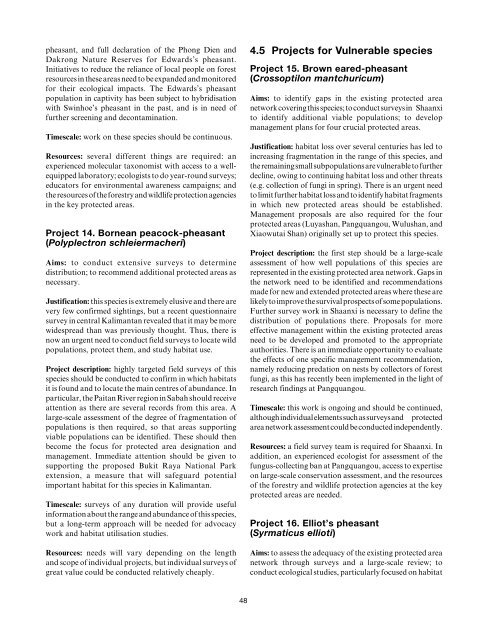Pheasants: Status Survey and Conservation Action Plan ... - IUCN
Pheasants: Status Survey and Conservation Action Plan ... - IUCN
Pheasants: Status Survey and Conservation Action Plan ... - IUCN
Create successful ePaper yourself
Turn your PDF publications into a flip-book with our unique Google optimized e-Paper software.
pheasant, <strong>and</strong> full declaration of the Phong Dien <strong>and</strong><br />
Dakrong Nature Reserves for Edwards’s pheasant.<br />
Initiatives to reduce the reliance of local people on forest<br />
resources in these areas need to be exp<strong>and</strong>ed <strong>and</strong> monitored<br />
for their ecological impacts. The Edwards’s pheasant<br />
population in captivity has been subject to hybridisation<br />
with Swinhoe’s pheasant in the past, <strong>and</strong> is in need of<br />
further screening <strong>and</strong> decontamination.<br />
Timescale: work on these species should be continuous.<br />
Resources: several different things are required: an<br />
experienced molecular taxonomist with access to a wellequipped<br />
laboratory; ecologists to do year-round surveys;<br />
educators for environmental awareness campaigns; <strong>and</strong><br />
the resources of the forestry <strong>and</strong> wildlife protection agencies<br />
in the key protected areas.<br />
Project 14. Bornean peacock-pheasant<br />
(Polyplectron schleiermacheri)<br />
Aims: to conduct extensive surveys to determine<br />
distribution; to recommend additional protected areas as<br />
necessary.<br />
Justification: this species is extremely elusive <strong>and</strong> there are<br />
very few confirmed sightings, but a recent questionnaire<br />
survey in central Kalimantan revealed that it may be more<br />
widespread than was previously thought. Thus, there is<br />
now an urgent need to conduct field surveys to locate wild<br />
populations, protect them, <strong>and</strong> study habitat use.<br />
Project description: highly targeted field surveys of this<br />
species should be conducted to confirm in which habitats<br />
it is found <strong>and</strong> to locate the main centres of abundance. In<br />
particular, the Paitan River region in Sabah should receive<br />
attention as there are several records from this area. A<br />
large-scale assessment of the degree of fragmentation of<br />
populations is then required, so that areas supporting<br />
viable populations can be identified. These should then<br />
become the focus for protected area designation <strong>and</strong><br />
management. Immediate attention should be given to<br />
supporting the proposed Bukit Raya National Park<br />
extension, a measure that will safeguard potential<br />
important habitat for this species in Kalimantan.<br />
Timescale: surveys of any duration will provide useful<br />
information about the range <strong>and</strong> abundance of this species,<br />
but a long-term approach will be needed for advocacy<br />
work <strong>and</strong> habitat utilisation studies.<br />
Resources: needs will vary depending on the length<br />
<strong>and</strong> scope of individual projects, but individual surveys of<br />
great value could be conducted relatively cheaply.<br />
4.5 Projects for Vulnerable species<br />
Project 15. Brown eared-pheasant<br />
(Crossoptilon mantchuricum)<br />
Aims: to identify gaps in the existing protected area<br />
network covering this species; to conduct surveys in Shaanxi<br />
to identify additional viable populations; to develop<br />
management plans for four crucial protected areas.<br />
Justification: habitat loss over several centuries has led to<br />
increasing fragmentation in the range of this species, <strong>and</strong><br />
the remaining small subpopulations are vulnerable to further<br />
decline, owing to continuing habitat loss <strong>and</strong> other threats<br />
(e.g. collection of fungi in spring). There is an urgent need<br />
to limit further habitat loss <strong>and</strong> to identify habitat fragments<br />
in which new protected areas should be established.<br />
Management proposals are also required for the four<br />
protected areas (Luyashan, Pangquangou, Wulushan, <strong>and</strong><br />
Xiaowutai Shan) originally set up to protect this species.<br />
Project description: the first step should be a large-scale<br />
assessment of how well populations of this species are<br />
represented in the existing protected area network. Gaps in<br />
the network need to be identified <strong>and</strong> recommendations<br />
made for new <strong>and</strong> extended protected areas where these are<br />
likely to improve the survival prospects of some populations.<br />
Further survey work in Shaanxi is necessary to define the<br />
distribution of populations there. Proposals for more<br />
effective management within the existing protected areas<br />
need to be developed <strong>and</strong> promoted to the appropriate<br />
authorities. There is an immediate opportunity to evaluate<br />
the effects of one specific management recommendation,<br />
namely reducing predation on nests by collectors of forest<br />
fungi, as this has recently been implemented in the light of<br />
research findings at Pangquangou.<br />
Timescale: this work is ongoing <strong>and</strong> should be continued,<br />
although individual elements such as surveys <strong>and</strong> protected<br />
area network assessment could be conducted independently.<br />
Resources: a field survey team is required for Shaanxi. In<br />
addition, an experienced ecologist for assessment of the<br />
fungus-collecting ban at Pangquangou, access to expertise<br />
on large-scale conservation assessment, <strong>and</strong> the resources<br />
of the forestry <strong>and</strong> wildlife protection agencies at the key<br />
protected areas are needed.<br />
Project 16. Elliot’s pheasant<br />
(Syrmaticus ellioti)<br />
Aims: to assess the adequacy of the existing protected area<br />
network through surveys <strong>and</strong> a large-scale review; to<br />
conduct ecological studies, particularly focused on habitat<br />
48
















